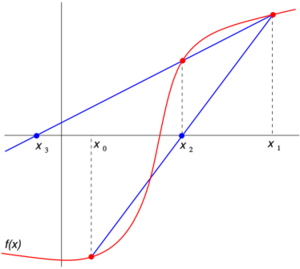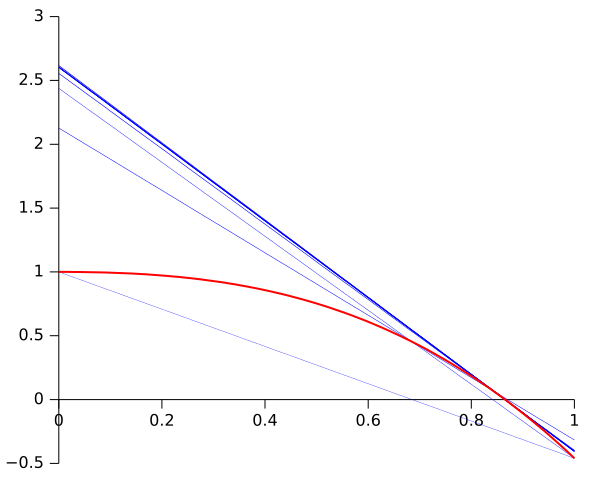Secant method
In numerical analysis, the secant method is a root-finding algorithm that uses a succession of roots of secant lines to better approximate a root of a function f. The secant method can be thought of as a finite-difference approximation of Newton's method. However, the secant method predates Newton's method by over 3000 years.[1]
The method
For finding a zero of a function f, the secant method is defined by the recurrence relation.
- [math]\displaystyle{ x_n = x_{n-1} - f(x_{n-1}) \frac{x_{n-1} - x_{n-2}}{f(x_{n-1}) - f(x_{n-2})} = \frac{x_{n-2} f(x_{n-1}) - x_{n-1} f(x_{n-2})}{f(x_{n-1}) - f(x_{n-2})}. }[/math]
As can be seen from this formula, two initial values x0 and x1 are required. Ideally, they should be chosen close to the desired zero.
Derivation of the method
Starting with initial values x0 and x1, we construct a line through the points (x0, f(x0)) and (x1, f(x1)), as shown in the picture above. In slope–intercept form, the equation of this line is
- [math]\displaystyle{ y = \frac{f(x_1) - f(x_0)}{x_1 - x_0}(x - x_1) + f(x_1). }[/math]
The root of this linear function, that is the value of x such that y = 0 is
- [math]\displaystyle{ x = x_1 - f(x_1) \frac{x_1 - x_0}{f(x_1) - f(x_0)}. }[/math]
We then use this new value of x as x2 and repeat the process, using x1 and x2 instead of x0 and x1. We continue this process, solving for x3, x4, etc., until we reach a sufficiently high level of precision (a sufficiently small difference between xn and xn−1):
- [math]\displaystyle{ \begin{align} x_2 & = x_1 - f(x_1) \frac{x_1 - x_0}{f(x_1) - f(x_0)}, \\[6pt] x_3 & = x_2 - f(x_2) \frac{x_2 - x_1}{f(x_2) - f(x_1)}, \\[6pt] & \,\,\,\vdots \\[6pt] x_n & = x_{n-1} - f(x_{n-1}) \frac{x_{n-1} - x_{n-2}}{f(x_{n-1}) - f(x_{n-2})}. \end{align} }[/math]
Convergence
The iterates [math]\displaystyle{ x_n }[/math] of the secant method converge to a root of [math]\displaystyle{ f }[/math] is,if the initial values [math]\displaystyle{ x_0 }[/math] and [math]\displaystyle{ x_1 }[/math] are sufficiently close to the root. The order of convergence is φ, where
- [math]\displaystyle{ \varphi = \frac{1+\sqrt{5}}{2} \approx 1.618 }[/math]
is the golden ratio. In particular, the convergence is super linear, but not quite quadratic.
This result only holds under some technical conditions, namely that [math]\displaystyle{ f }[/math] be twice continuously differentiable and the root in question be simple (i.e., with multiplicity 1).
If the initial values are not close enough to the root, then there is no guarantee that the secant method converges. There is no general definition of "close enough", but the criterion has to do with how "wiggly" the function is on the interval [math]\displaystyle{ [x_0, x_1] }[/math]. For example, if [math]\displaystyle{ f }[/math] is differentiable on that interval and there is a point where [math]\displaystyle{ f' = 0 }[/math] on the interval, then the algorithm may not converge.
Comparison with other root-finding methods
The secant method does not require that the root remain bracketed, like the bisection method does, and hence it does not always converge. The false position method (or regula falsi) uses the same formula as the secant method. However, it does not apply the formula on [math]\displaystyle{ x_{n-1} }[/math] and [math]\displaystyle{ x_{n-2} }[/math], like the secant method, but on [math]\displaystyle{ x_{n-1} }[/math] and on the last iterate [math]\displaystyle{ x_k }[/math] such that [math]\displaystyle{ f(x_k) }[/math] and [math]\displaystyle{ f(x_{n-1}) }[/math] have a different sign. This means that the false position method always converges; however, only with a linear order of convergence. Bracketing with a super-linear order of convergence as the secant method can be attained with improvements to the false position method (see Regula falsi § Improvements in regula falsi) such as the ITP method or Illinois method.
The recurrence formula of the secant method can be derived from the formula for Newton's method
- [math]\displaystyle{ x_n = x_{n-1} - \frac{f(x_{n-1})}{f'(x_{n-1})} }[/math]
by using the finite-difference approximation, for a small [math]\displaystyle{ \epsilon }[/math]:
[math]\displaystyle{ f'(x_{n-1}) \approx \frac{f(x_{n-1}) - f(x_{n-2})}{x_{n-1} - x_{n-2}} \approx {\frac {f(x_{n-1}+{\frac {\epsilon }{2}})-f(x_{n-1}-{\frac {\epsilon }{2}})}{\epsilon }} }[/math]
The secant method can be interpreted as a method in which the derivative is replaced by an approximation and is thus a quasi-Newton method.
If we compare Newton's method with the secant method, we see that Newton's method converges faster (order 2 against φ ≈ 1.6). However, Newton's method requires the evaluation of both [math]\displaystyle{ f }[/math] and its derivative [math]\displaystyle{ f' }[/math] at every step, while the secant method only requires the evaluation of [math]\displaystyle{ f }[/math]. Therefore, the secant method may occasionally be faster in practice. For instance, if we assume that evaluating [math]\displaystyle{ f }[/math] takes as much time as evaluating its derivative and we neglect all other costs, we can do two steps of the secant method (decreasing the logarithm of the error by a factor φ2 ≈ 2.6) for the same cost as one step of Newton's method (decreasing the logarithm of the error by a factor 2), so the secant method is faster. If, however, we consider parallel processing for the evaluation of the derivative, Newton's method proves its worth, being faster in time, though still spending more steps.
Generalization
Broyden's method is a generalization of the secant method to more than one dimension.
The following graph shows the function f in red and the last secant line in bold blue. In the graph, the x intercept of the secant line seems to be a good approximation of the root of f.
Computational example
Below, the secant method is implemented in the Python programming language.
It is then applied to find a root of the function f(x) = x2 − 612 with initial points [math]\displaystyle{ x_0 = 10 }[/math] and [math]\displaystyle{ x_1 = 30 }[/math]
def secant_method(f, x0, x1, iterations):
"""Return the root calculated using the secant method."""
for i in range(iterations):
x2 = x1 - f(x1) * (x1 - x0) / float(f(x1) - f(x0))
x0, x1 = x1, x2
return x2
def f_example(x):
return x ** 2 - 612
root = secant_method(f_example, 10, 30, 5)
print(f"Root: {root}") # Root: 24.738633748750722
Notes
- ↑ Papakonstantinou, Joanna; Tapia, Richard (2013). "Origin and evolution of the secant method in one dimension". American Mathematical Monthly 120 (6): 500-518. doi:10.4169/amer.math.monthly.120.06.500. https://www.jstor.org/stable/10.4169/amer.math.monthly.120.06.500.
See also
References
- Avriel, Mordecai (1976). Nonlinear Programming: Analysis and Methods. Prentice Hall. pp. 220–221. ISBN 0-13-623603-0.
- Allen, Myron B.; Isaacson, Eli L. (1998). Numerical analysis for applied science. John Wiley & Sons. pp. 188–195. ISBN 978-0-471-55266-6. https://books.google.com/books?id=PpB9cjOxQAQC.
External links
- Secant Method Notes, PPT, Mathcad, Maple, Mathematica, Matlab at Holistic Numerical Methods Institute
- Weisstein, Eric W.. "Secant Method". http://mathworld.wolfram.com/SecantMethod.html.



